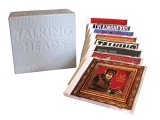

Talking Heads
Remain in Light
(Sire/Rhino)
First Appeared in The Music Box, March 2006, Volume 13, #3
Written by John Metzger
![]()
Released in 1980, Remain in Light was the culmination of Talking Headsí initial vision, and in hindsight, itís the album that the band struggled to surpass for the remainder of its career. Because the groupís creative impulses were tempered by a combination of external pressures and internal strife, its subsequent outings, particularly Speaking in Tongues and Naked, followed a functional but familiar pattern of fusing a pop-oriented A-side with an atmospheric B-side. Consequently, Remain in Light marked the pinnacle of the ensembleís considerably stellar catalogue.
Building upon the percussive drive that propelled Fear of Musicís opening cut I Zimbra, Remain in Light was a full-blown exploration of polyrhythmic ebb and flow, and it effectively bridged the gap that divided the edgy aesthetic of punk from the dance-friendly ambience of disco. On earlier efforts, David Byrneís lyrics had been constructed around the notion of repetition, but here his phrasing as well as the employment of staggered choruses and gospel-tinged chorales joined the circular grooves concocted by Chris Frantz and Tina Weymouth to form an relentlessly fluid cadence. Painted by electronic blips and bleeps and shaded with short bursts of guitar, Remain in Lightís opening half organically shifted from the elastic Born under Punches (The Heat Goes On) to the hypnotic pulse of Crosseyed and Painless to the nervously agitated, James Brown-on-amphetamines fury of The Great Curve. Its latter half began with the watery refrains of Once in a Lifetime but grew increasingly experimental with each ensuing track. Throughout the set, Adrian Belewís guitar accompaniments cut through the intricately layered music with razor-sharp precision, most notably adding gentle wisps to Listening Wind and an ominous, buzz saw effect to the baptismal awakening of Once in a Lifetime.
Immediately upon its release, Remain in Light was met with fawning praise from critics, and the passage of time only has served to solidify the albumís stature and highlight its widespread influence. Houses in Motion, for example, provides the link between Pearl Jamís Push Me, Pull Me and the material on Jim Morrisonís An American Prayer; Seen and Not Seenís monotonic vocals were lifted by Radiohead for OK Computerís Fitter Happier; The Overload connected David Bowieís 1977 outing Low with his 1995 endeavor Outside; and the concept of merging African grooves with rock ínĎ roll predated Paul Simonís Graceland by six years.
Given the density of Remain in Lightís arrangements, it isnít
surprising that the album fares remarkably well as a surround sound recording.
On Crosseyed and Painless, for example, the effects not only swoop from
back to front, but they also wrap around the edges of the aural spectrum,
essentially curling around the songís driving groove. Elsewhere, the
effervescent disorientation of Once in a Lifetimeís surreal world is
seriously enhanced by its newly mixed, three-dimensional ambience. Augmenting
the collection are four unfinished outtakes plus a pair of solid, live
performances from the German television show Rockpop, but itís the
original album that remains engaging...same as it ever was. ![]()
![]()
![]()
![]()
![]()
![]()
![]()
![]()
Remain in Light [DUALDISC] is available from Barnes & Noble.
To order, Click Here!
Brick [Box Set] is available from Barnes & Noble.
To order, Click Here!
![]()
Ratings
1 Star: Pitiful
2 Stars: Listenable
3 Stars: Respectable
4 Stars: Excellent
5 Stars: Can't Live Without It!!
![]()
Copyright © 2006 The Music Box
